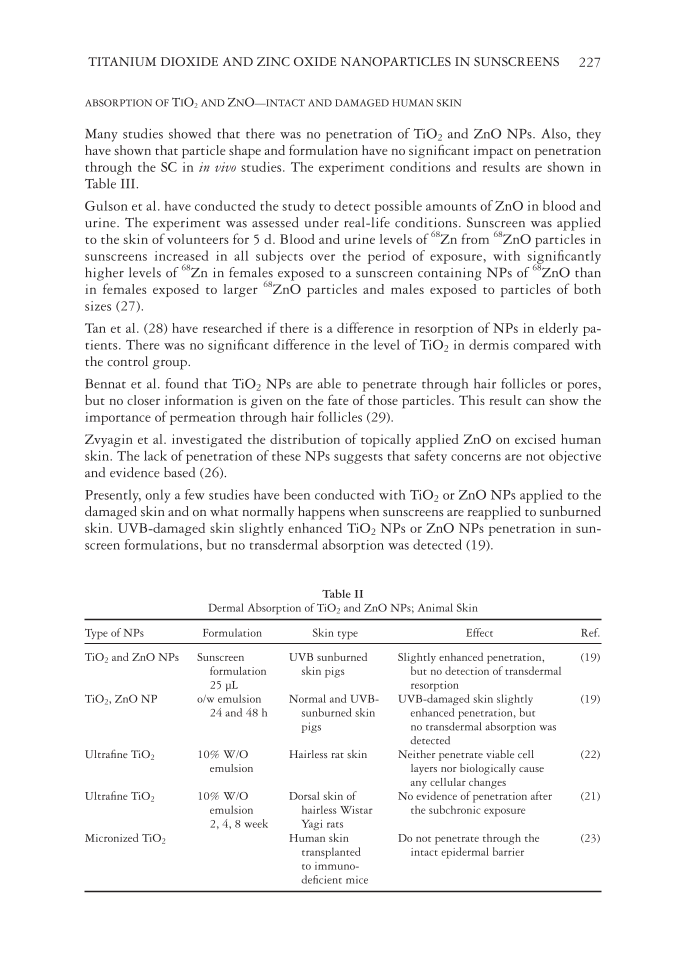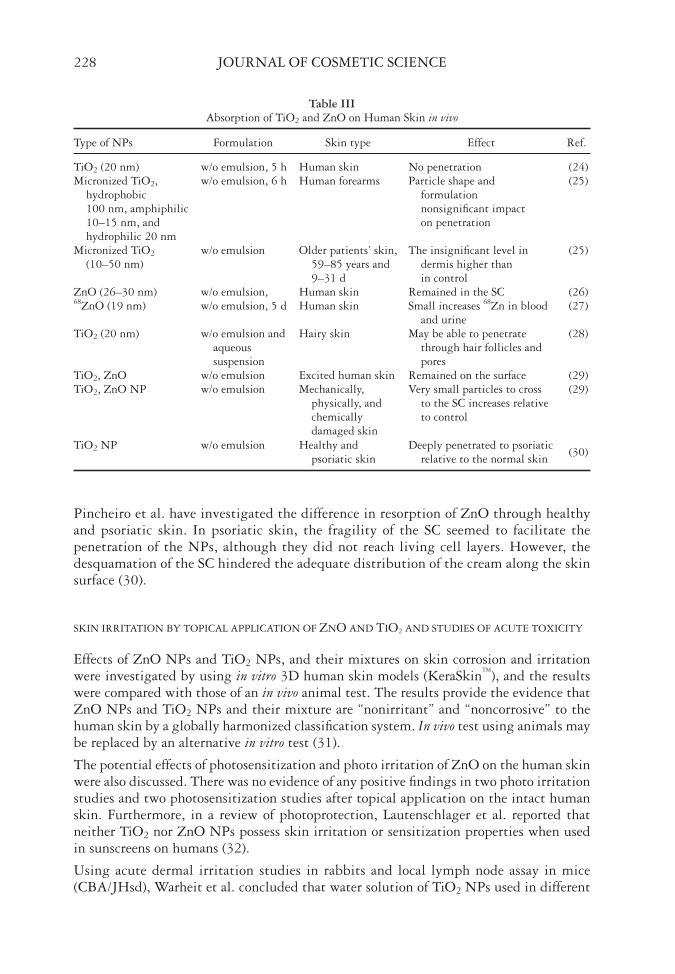TITANIUM DIOXIDE AND ZINC OXIDE NANOPARTICLES IN SUNSCREENS 227 ABSORPTION OF TIO2 AND ZNO—INTACT AND DAMAGED HUMAN SKIN Many studies showed that there was no penetration of TiO2 and ZnO NPs. Also, they have shown that particle shape and formulation have no signifi cant impact on penetration through the SC in in vivo studies. The experiment conditions and results are shown in Table III. Gulson et al. have conducted the study to detect possible amounts of ZnO in blood and urine. The experiment was assessed under real-life conditions. Sunscreen was applied to the skin of volunteers for 5 d. Blood and urine levels of 68 Zn from 68 ZnO particles in sunscreens increased in all subjects over the period of exposure, with signifi cantly higher levels of 68 Zn in females exposed to a sunscreen containing NPs of 68 ZnO than in females exposed to larger 68 ZnO particles and males exposed to particles of both sizes (27). Tan et al. (28) have researched if there is a difference in resorption of NPs in elderly pa- tients. There was no signifi cant difference in the level of TiO2 in dermis compared with the control group. Bennat et al. found that TiO2 NPs are able to penetrate through hair follicles or pores, but no closer information is given on the fate of those particles. This result can show the importance of permeation through hair follicles (29). Zvyagin et al. investigated the distribution of topically applied ZnO on excised human skin. The lack of penetration of these NPs suggests that safety concerns are not objective and evidence based (26). Presently, only a few studies have been conducted with TiO2 or ZnO NPs applied to the damaged skin and on what normally happens when sunscreens are reapplied to sunburned skin. UVB-damaged skin slightly enhanced TiO2 NPs or ZnO NPs penetration in sun- screen formulations, but no transdermal absorption was detected (19). Table II Dermal Absorption of TiO2 and ZnO NPs Animal Skin Type of NPs Formulation Skin type Effect Ref. TiO2 and ZnO NPs Sunscreen formulation 25 μL UVB sunburned skin pigs Slightly enhanced penetration, but no detection of transdermal resorption (19) TiO2, ZnO NP o/w emulsion 24 and 48 h Normal and UVB- sunburned skin pigs UVB-damaged skin slightly enhanced penetration, but no transdermal absorption was detected (19) Ultrafi ne TiO2 10% W/O emulsion Hairless rat skin Neither penetrate viable cell layers nor biologically cause any cellular changes (22) Ultrafi ne TiO2 10% W/O emulsion 2, 4, 8 week Dorsal skin of hairless Wistar Yagi rats No evidence of penetration after the subchronic exposure (21) Micronized TiO2 Human skin transplanted to immuno- defi cient mice Do not penetrate through the intact epidermal barrier (23)
JOURNAL OF COSMETIC SCIENCE 228 Pincheiro et al. have investigated the difference in resorption of ZnO through healthy and psoriatic skin. In psoriatic skin, the fragility of the SC seemed to facilitate the penetration of the NPs, although they did not reach living cell layers. However, the desquamation of the SC hindered the adequate distribution of the cream along the skin surface (30). SKIN IRRITATION BY TOPICAL APPLICATION OF ZNO AND TIO2 AND STUDIES OF ACUTE TOXICITY Effects of ZnO NPs and TiO2 NPs, and their mixtures on skin corrosion and irritation were investigated by using in vitro 3D human skin models (KeraSkin™), and the results were compared with those of an in vivo animal test. The results provide the evidence that ZnO NPs and TiO2 NPs and their mixture are “nonirritant” and “noncorrosive” to the human skin by a globally harmonized classifi cation system. In vivo test using animals may be replaced by an alternative in vitro test (31). The potential effects of photosensitization and photo irritation of ZnO on the human skin were also discussed. There was no evidence of any positive fi ndings in two photo irritation studies and two photosensitization studies after topical application on the intact human skin. Furthermore, in a review of photoprotection, Lautenschlager et al. reported that neither TiO2 nor ZnO NPs possess skin irritation or sensitization properties when used in sunscreens on humans (32). Using acute dermal irritation studies in rabbits and local lymph node assay in mice (CBA/JHsd), Warheit et al. concluded that water solution of TiO2 NPs used in different Table III Absorption of TiO2 and ZnO on Human Skin in vivo Type of NPs Formulation Skin type Effect Ref. TiO2 (20 nm) w/o emulsion, 5 h Human skin No penetration (24) Micronized TiO2, hydrophobic 100 nm, amphiphilic 10–15 nm, and hydrophilic 20 nm w/o emulsion, 6 h Human forearms Particle shape and formulation nonsignifi cant impact on penetration (25) Micronized TiO2 (10–50 nm) w/o emulsion Older patients’ skin, 59–85 years and 9–31 d The insignifi cant level in dermis higher than in control (25) ZnO (26–30 nm) w/o emulsion, Human skin Remained in the SC (26) 68 ZnO (19 nm) w/o emulsion, 5 d Human skin Small increases 68 Zn in blood and urine (27) TiO2 (20 nm) w/o emulsion and aqueous suspension Hairy skin May be able to penetrate through hair follicles and pores (28) TiO2, ZnO w/o emulsion Excited human skin Remained on the surface (29) TiO2, ZnO NP w/o emulsion Mechanically, physically, and chemically damaged skin Very small particles to cross to the SC increases relative to control (29) TiO2 NP w/o emulsion Healthy and psoriatic skin Deeply penetrated to psoriatic relative to the normal skin (30)
Purchased for the exclusive use of nofirst nolast (unknown) From: SCC Media Library & Resource Center (library.scconline.org)


















































